St James the Less Roman Catholic Church
150th Anniversary Booklet
Early Church History Download booklet as PDF here.
The War Years and The Depression Email macclesfieldhistory@gmail.com for a HQ version.
Footbridge
The Convent and School
Canonisation of Sister Mary MacKillop
Annual Concerts
Catholic Sports Picnics
End Note
Timeline
St. James the Less Catholic Church
150th Anniversary 1867–2017
5th November 2017, Macclesfield, SA
Early Church History
The large Parish of Mount Barker that included Macclesfield was established in 1848, the first Parish Priest being the Reverend Father James Watkins. His enormous Parish stretched from the Victorian border in the east to St. Vincents Gulf in the west and south including Kangaroo Island.
At this time land on which to build Churches was being eagerly sought and a newspaper report for the 16th December 1854 noted that a meeting was held at Mr. Lewis’ Davenport Arms Hotel “to arrange for the building of a Roman Catholic Church at Macclesfield”. Land was offered for this purpose, possibly where the local milk factory was later built, by a Mr. Sutter “he being a gentleman not of their creed”.
However, concern was expressed about people needing to cross the “sometimes ferocious river” at this point and another three blocks became available in Luck Street where the Church now stands. These blocks were owned by Mr. Nichol Mein of London and Mr. Charles Stirling, late of Adelaide, and were transferred to the Church on December 29th 1856.
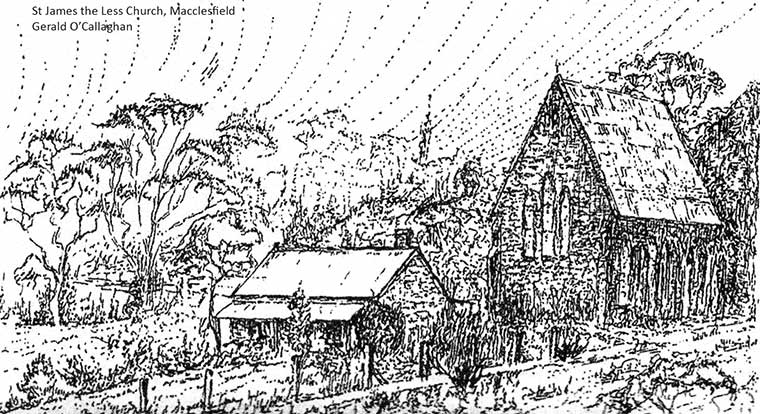
Sketch by Gerald O’Callaghan showing the church and the first convent (some artistic license here - the convent was really next to the church, or, perhaps it represents the original slab convent).
The South Australian Register newspaper of April 10th 1858 contained an article stating that “In Macclesfield the Congregationists have completed a neat and substantial Chapel and a small Church has been built by the Episcopalians. The Wesleyans have recently laid the foundations for a Chapel and the Roman Catholics assemble for worship in a slab tenement”.
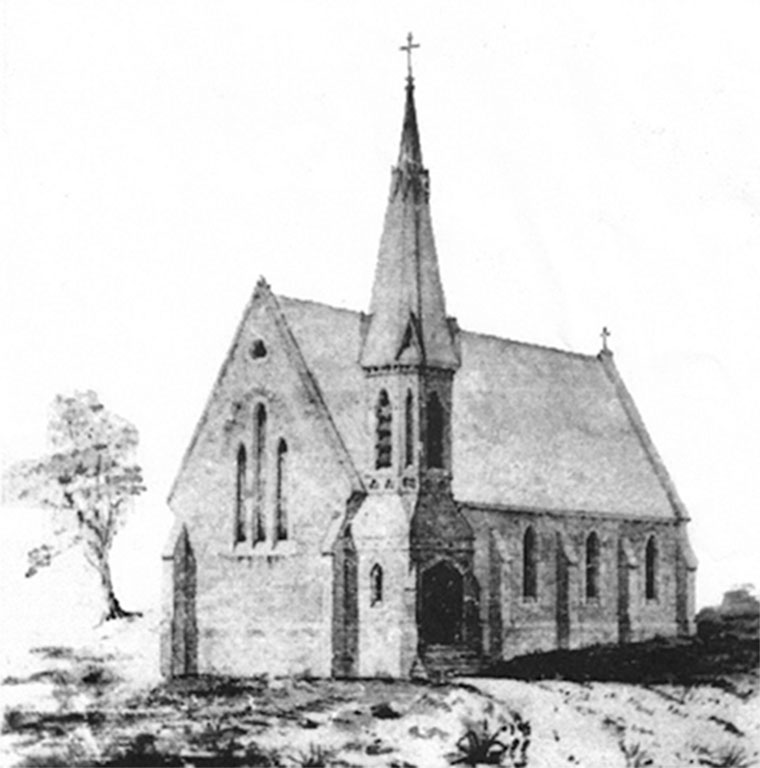
St James with the proposed spire that unfortunately was never built.
The ‘Register’ of October 29th 1866 contained a report of the visit of the Right Reverend Dr. Shiel Bishop of Adelaide who "administered the Sacrament of Confirmation in Macclesfield on Sunday the 14th instant. His Lordship left Adelaide on Saturday accompanied by the Very Rev. J. Smyth, Vicar General, and arrived in Macclesfield at 3 o’clock in the afternoon.
As soon as the Catholics of the district became aware that their Bishop was about to visit them they resolved to give him as good a welcome as the short notice of his intended visit would permit. Nearly 40 horsemen rode as far as Echunga where they met him and conducted him in triumph to Macclesfield. When the carriage stopped at the Davenport Arms Hotel His Lordship thanked them for the mark of respect they had paid him. Three hearty cheers were given twice over for the Bishop and three cheers for the Vicar General. An address was then presented to him in the long room.
On Sunday morning the Bishop, attended by the Vicar General and Rev. Father Dowling, administered Confirmation to about 40. At the conclusion of the ceremony His Lordship called upon the people to take immediate steps for a building 'becoming to the Glory of God'. Many people came forward and in a few minutes the sum of £215.0.0 was contributed. After Mass on Monday His Lordship paid a short visit to Strathalbyn where he hoped soon to have a Church erected for the Catholics of that township and the adjoining area”.
New Church Built
A committee chaired by Mr. Michael Darmody began to plan a stone building for about 4/- a yard, exclusive of materials, and with considerable assistance from the parishioners.
The South Australian Weekly Chronicle carried a report of the proceedings noting that “The Church is planned for future enlargement should it be necessary. It is of the Gothic style of architecture and very credible to the Architects and the contractor. It is 50 feet long and 25 wide and 16 feet from floor line. It is ceiled but not yet plastered as the congregation wished to leave other decoration for another contract.”
The image displayed on the previous page of this booklet is an early sketch of St James The Less Catholic Church, Macclesfield, with the proposed Spire, as drawn up by the Architects, Messrs. Wright and Woods in 1867. It was decided to leave the Spire to be added at a later date, but unfortunately this did not happen!
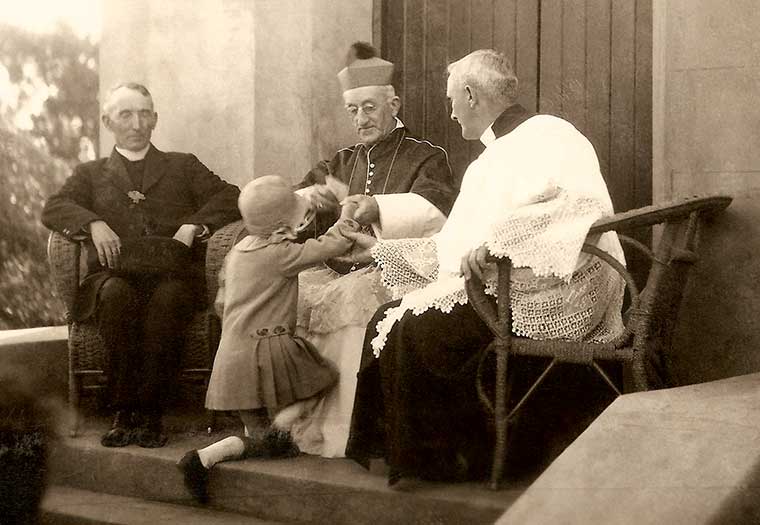
Joan McNamara presents an address from the school children to Archbishop Spence with Fr. Aylward (L) and Fr. F. Gatzmeyer (R).
“The plan drawn up by architects Messrs. Wright and Woods was adopted and the contract let to Mr. Hague. The foundation stone was laid by Rev. Father J. Smyth and the new Church of St. James the Less was dedicated by the Very Rev. Father Smyth, Vicar General, on Sunday November 3rd 1867 before a large assembly of approximately 350 people. By the zeal of the ladies a good platform and beautiful altar were erected for the opening.
At the close of the ceremony the first Mass in the Church was celebrated by Parish Priest Rev. J. Dowling and the Vicar General preached the sermon. The Church is still considerably in debt but by the energy of the Reverends J. Dowling and Van der Heyden who have done so much already, and of the congregation, the entire debt will soon be cancelled”.
So began the History of the Church of St. James the Less, Macclesfield. The first wedding in the new church was solemnised by Fr. T Dowling on November 14th 1867. The Bride was Catherine Ryan of Macclesfield and the Groom was William Burley of Meadows. Witnesses were Laurence Thomber of Strathalbyn and Margaret Lewis of Macclesfield.
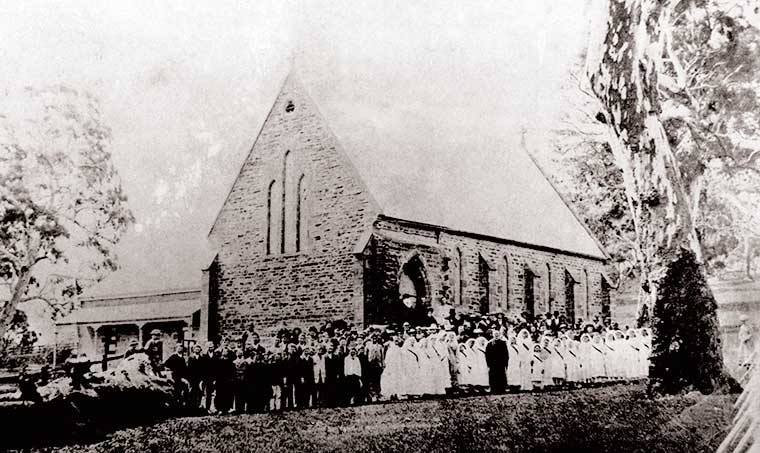

Confirmation 7 Oct 1886 at St James the Less. This is our earliest photograph.
Contact the Macclesfield History Group via our website if you have any early photographs of good quality. www.macclesfieldhistory.com.au
Inset shows clothing worn at the time.
The date of the first baptism is not known. The Mount Barker Catholic Records held at the Catholic Archives have entries of Baptisms from 1840 but no details of where the ceremony actually took place.
Marriages and deaths are also recorded with many Irish sounding names, details and places of residence being Macclesfield, Bull Creek, Meadows, Angas, Tory Banks, Bugle Ranges, Long Valley, Greenhills and Paris Creek. Many of the older residents are buried in the Mount Barker Catholic Cemetery. The Macclesfield Public Cemetery was established in 1883 and the Catholics granted an area ‘but not to be fenced off.’
1906 New Parish Boundaries
The turn of the century came and went and an article from the Southern Cross on the 16th Feb. 1906 noted that “Two new parishes have been formed in the archdiocese. One of the parishes consists of Macclesfield and Strathalbyn, which are at present included in the Mount Barker parish and Port Elliot which forms part of the parish of Willunga. The Rev. Fr. F.J. Adamson, assistant Priest of Mount Barker, has been appointed to the charge of this parish. The other new parish is formed in Yorke’s Peninsula”.
In his letter accepting the appointment Fr. Adamson wrote that “Fr. Landy and I have decided on a point halfway between Mount Barker and Macclesfield as the present boundary of this district.” Thus St. James Church at Macclesfield was then known as being in the Strathalbyn Parish.
The War Years and The Depression
The years of World War I brought much fund raising for the ‘war effort’ together with special blessings and presentations to Defense Personnel on Embarkation Leave, and Thanksgiving Masses on their safe return.
The emphasis was on the war effort, knitting scarves and balaclavas for the forces and writing letters to old scholars on active service, collecting metal and newspapers, whatever was needed. Once again children were trained for any emergency and food rationing meant that food was again shared with anyone in need. Cooking lessons in the Convent kitchen resulted in meals sent to older or sick people and especially welcomed in our cold winters.
Church life continued as usual through the Depression years with Baptisms, First Communions and Marriages celebrated and the beginning of World War II brought a repeat of the World War I years. Special prayer days were held and again as elsewhere fund raising for the war effort.
1927 Diamond Jubilee, 60th Anniversary
Meanwhile, upkeep on all buildings was delayed and in 1917 some needed repair work was done and then major renovation of the Church and surrounds took place for the Diamond Jubilee in 1927.
The present stained glass windows are not the original ones as older photographs show diamond paned glass and we are not sure when this change was made. Tradition has it that it was in 1917 when families donated a window in memory of parents etc and this seems to be borne out by the ‘commemorative plaques’ near each one. Further repairs were carried out in 1977 for the 110th anniversary.
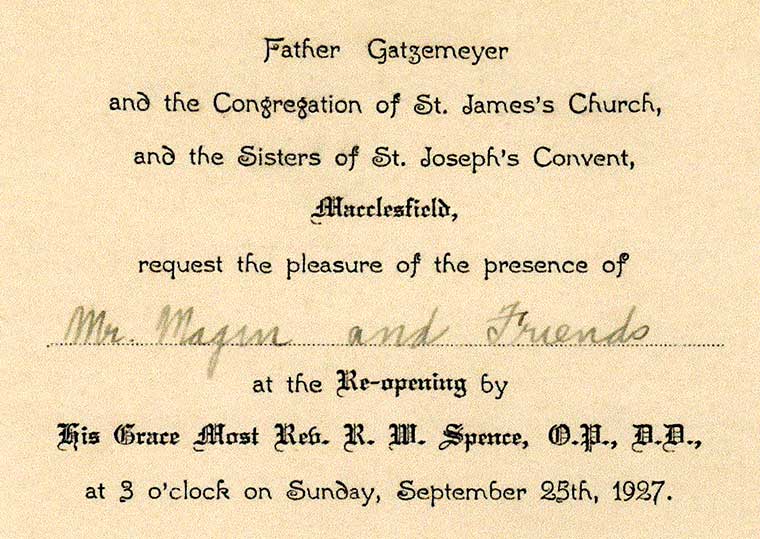
Invitation to "Mr Magin and Friends" to the 1927 Diamond Jubilee
The Southern Cross newspaper carried a report of the re-dedication of the Church by Archbishop Most Reverand Dr. Spence O.P. on September 27th 1927. “There was a large gathering present with many visitors, mostly former residents and their friends, who made it a celebration of a Back to Macclesfield event and a festive spirit prevailed. Among the crowd of familiar faces were Reverands Alyward, Parish Priest of Mount Barker, and Frs. O’Connell and Eviston. The grounds resembled a picnic meeting, the surrounds being decorated with bunting, afternoon tea and refreshments were available in a large marquee, while an orchestra played music.
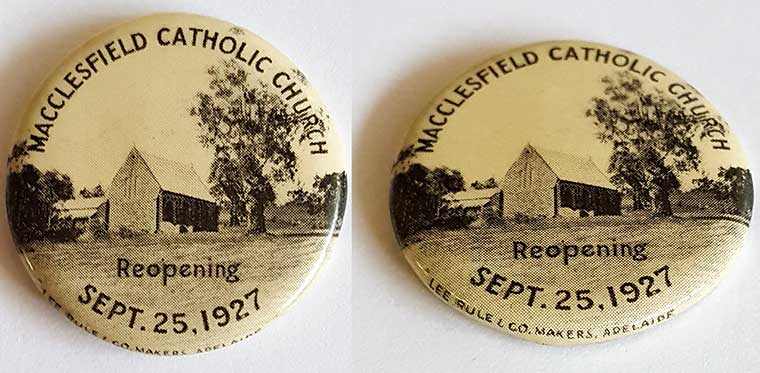
Badge sold to raise monies for the repairs of the church at the Diamond Jubilee.
His Grace celebrated Mass assisted by Fr. F. Gatzmeyer (Parish Priest). In introducing the Archbishop, Fr. Gatzmeyer pointed out that there had been delay in carrying out the renovations owing to the difficulty of securing contractors but eventually the work was done to the entire satisfaction of all concerned. During his address, the Archbishop dealt briefly with the fact that had not the early pioneers paved the way for places of devotion St. James would not be as it is today and he expressed the hope that the Church would do service for at least another 60 years and appealed for funds to assist with the cost of renovation. A collection was taken which together with the sale of buttons (see image) amounted to £220. Benediction of the Blessed Sacrament was then given by the Archbishop and the celebrations concluded as the crowd began to wend their separate ways.”
August 15th is a special Feast Day on the Catholic calendar and in 1945 before Mass the Priest came to the altar and announced the end of the war. Heads were bowed in silent thanksgiving and thoughts went to those who had lost members of their families, with special thoughts for a local family who were in the congregation as two of their sons would not be returning. After the Mass, many people stayed for private prayer, including the Italian Prisoners of War who worked on surrounding farms and who filled the back of the Church. Some had tears in their eyes at the thought that now they could be repatriated to their homes and loved ones.
1977 Anniversary: Macclesfield Church 110 years old
Some changes in the wider Church occurred during the Vatican Council in 1962, and in 1970 during Fr. Terry Wall’s time in our Parish the Altar was turned around so that the Priest could invite the people to offer Mass with him. English replaced Latin as the language of the Mass, Altar rails and cloths were removed and the congregation were encouraged to take more part in the service. These changes required more upgrading in the Church building and a decision was made to complete them as money became available.
By 1973 Mr. G.E. Hodgson, Building Consultant, reported on necessary repairs. First the cement render on the outside walls which had been done in 1927 to prevent water seeping in had cracked and needed to be removed. Volunteers were able to do that work and the stonework was then pointed as it was in 1867, and it was necessary to cover the buttresses to waterproof that stone. Messrs. B. and F. Keighran were the tradesmen.
When the work was being done the original foundation stone to the east of the front door was uncovered and a glass jar cemented in the cavity was found containing specifications and prices for renovations to the buildings, together with a letter from Fr. Gatzmeyer (Parish Priest at the time), that he had placed there on June 24th 1927. Internal repairs including cracks in the plaster were treated and the Church rewired and lighting altered, walls were painted and wood paneling of the arch behind the Altar was installed, including a shelf to display the handsome brass candlesticks and Cross.
The two - stepped sanctuary area was replaced by a single step floor and carpet laid in that area in October 1977. Eventually that step too proved unnecessary and the whole floor is now on the same level. Meanwhile Parish Priest Fr. W. Modystack had worked on removing the paint from the front doors and had returned them to the original wood.
Gleaned from The Southern Argus, Thursday, 10th November 1977
“Parishioners, past and present, attended the special Mass and barbecue luncheon at St. James the Less, Roman Catholic Church, Macclesfield, last Sunday to commemorate the 110th Anniversary of the dedication of the building. It has undergone quite a lot of renovation and restoration over the years. The outer walls have recently been redressed and the inner walls lined with wood pannelling. Several very handsome pieces of brass work standing on a shelf behind the altar have also been added.
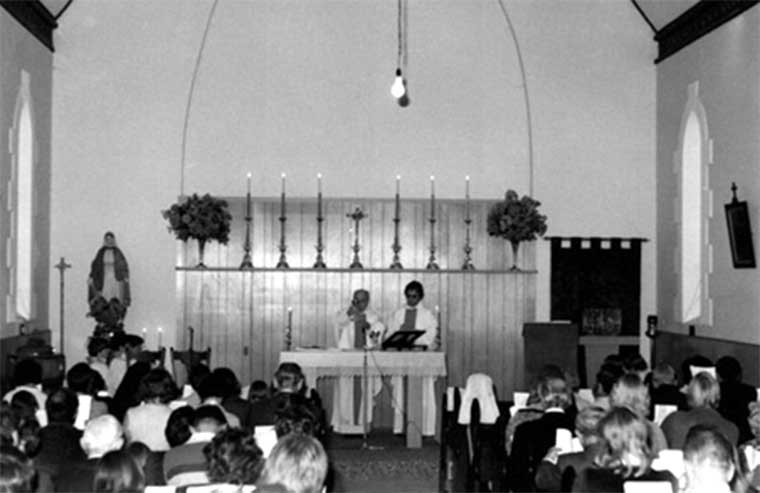
Brass candlesticks and Cross displayed on the shelf above the Altar in 1977
The celebration Mass with Principal Celebrant the Very Rev. Mgr. Thomas Horgan, P.A., V.G., P.P., Concelebrant Father William Modystack P.P., started with the beautiful music of Beethoven’s Choral Symphony "Song of Joy" sung as the processional.
Mr. M. Ferrarese and Mr O. Lemar were Lectors. The first reading was from the Book of Isaiah, the second from St. Paul's letter to the Colossians. The organist was Mary Thomas and the speaker Mr K P Thomas. Gwenythe Annear sang two solos during the service, 'O Esca Viatorum' written by an unknown 18th century composer and 'Ave Verum' by Mozart.
Sister Elizabeth Brown, Sister Kathleen Purcell and Madge and Martin Pursell (via their Picnic Fund they raised funds by collecting used bottles) formed the offertory procession. The six altar boys for this historic occasion were Paul and Graham Lemar and Phillip Mott of Macclesfield, Stephen Newland of Milang, Geoffrey Brook of Strathalbyn and Michael Swann of Kapunda.
There were several past pupils and teachers among the visitors including Sister Gwen who taught in Macclesfield from 1967 to 1971, Sister Marianna Sugrue who was a teacher from 1965 to 1966 and Sister Constance who was at the school when it closed in 1971. Also present was Sister Mary Reardon, Nun Provincial of the Sisters of St. Joseph in South Australia.
On sale were copies of “Strathalbyn Parish History Notes” researched and produced by Fr. W. Modystack who also researched and produced a book called “Mary MacKillop, A Woman before her Time” while in our Parish.
Also on view was a collection of photographs, school books, newspaper cuttings and records of the school. Mrs. Betty White was responsible for much of the display. Herself an old pupil of the school, she has spent many years in collecting documents and relics of Macclesfield”. (And still is in 2017 as a member of the Macclesfield History Group. Visit: www.macclesfieldhistory.com.au).
1992 125th Anniversary
“Church outlasts predicted lifespan to reach 125”
“The Catholic church of St James the Less at Macclesfield celebrated its 125th anniversary on Sunday. Several hundred people attended the service performed by Parish Priest Father Kerry Dwyer. Built in 1867 to replace the rough slab chapel built for worshippers years earlier, the church has already outlasted its predicted life”.
The church was unfinished (some plastering had to be done) at the time of its blessing and major renovations were undertaken for its Diamond Jubilee (60 years) in 1927. During those celebrations officials hoped the church would serve for another 60 years - and that was 65 years ago.
As part of the celebrations when the Church celebrated its 125th anniversary, the work of the sisters of St Joseph in the parish and at the school was remembered by the congregation when many of the visiting nuns were asked to plant commemorative trees on the grounds.
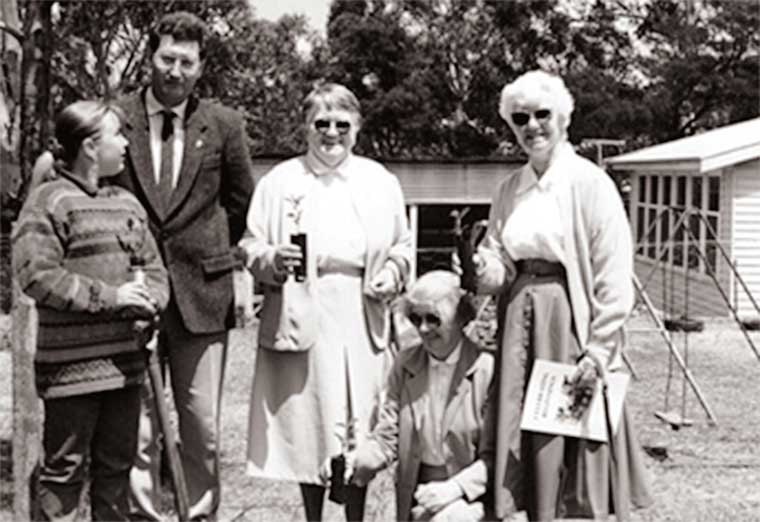
1992 Visiting nuns were asked to plant commemorative trees on the grounds.
A shared lunch was held in the old school rooms with the walls decorated with memorabilia of the parish history. Chalices, priestly robes, school memorabilia and a Missal dating back from the very early days of the parish were on display, and past photographs caused much amusement among old scholars and the Sisters.
A booklet “Celebrating Beginnings” compiled by parishioner Gerald O’Callaghan was also available on the day.
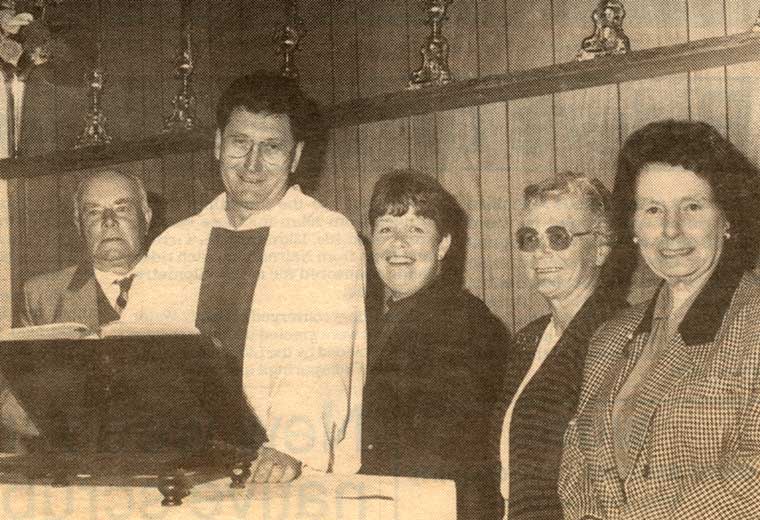
Inside the church at the 125th celebrations were (from left) Guerin McNamara, Father Kerry Dwyer, Colleen McNamara, Betty White and Alice Anderson.
1995: On June 11th 1995 the Mount Barker and Strathalbyn Parishes combined at Macclesfield for a celebration to honour Blessed Mary MacKillop and a special Mass was followed by a BYO picnic lunch.
2004: In the year 2004, after much consultation between all parties the Strathalbyn Parish was amalgamated with Mount Barker and became the current Mount Barker Strathalbyn Parish with Fr. Michael Rodger as Parish Priest at that time and so history was revisited.
2010: From August 2010 until May 2011 noted harpist and soprano Emma Horwood recorded songs for two CD’s and admired “your beautiful old Church with the best acoustics we have found”.
2012: A ‘time of sharing’ began in 2012 when the local Uniting Church parishioners held their Services in St. James Church while their usual venue, the Flaxley Hall, was upgraded. This arrangement suited everyone with a spirit of goodwill and joyful companionship clearly evident in both communities.
2015: During 2015–16 more renovations took place when parishioner Norbert Sobotta treated the outside of the Church with water repellent and stripped the paint from inside thus exposing the original render, then treated cracks where necessary and re-lined the walls as they were done in the past.
Footbridge
The footbridge from the main street across that branch of the river was first built in 1882. As it was a private bridge it was required by law that it be closed on one day of the year, and someone had to be there to police it. In later years turnstyles were placed at each end ‘for the sake of the safety of the public and the school children who attend the Convent School’ and some renovations were carried out.
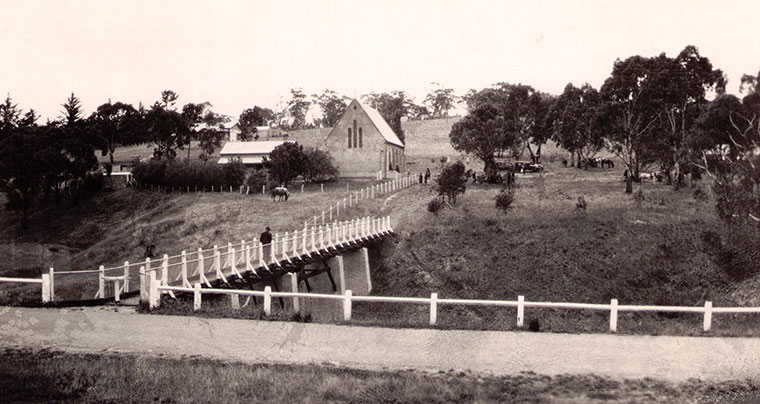
St. James The Less Catholic Church and footbridge c1936.
By 1936 the bridge was again in disrepair and a contract for repair of the woodwork was accepted by Messrs. Caldwell Bros. of Strathalbyn and for the repair of the masonry by Mr. F H Ross of Macclesfield.
A Gala Day was held in the Church Grounds on Sunday 7th June 1936 to celebrate the re-opening. Ribbons were cut by Fr. Aylward and then presented to Mrs. Pat Murphy who, as a child, was the first local to cross it when it was under construction. She had walked over the planks used by the workmen and was invited to be the first to cross it after the re-opening.
By 1987 the footbridge was again ‘structurally inadequate’ so a public right of way was agreed on and the local Council took oversite of the bridge which was then renovated ‘in a suitable manner’ by Strongcrete Constructions of Macclesfield.
The Convent and School
Order of Sisters of Saint Joseph of the Sacred Heart
St Mary of the Cross MacKillop
Born: 15 Jan 1842, Fitzroy near Melbourne.
Died: 8 August 1909, North Sydney, Sydney.
Mary Helen MacKillop RSJ, now formally known as St Mary of the Cross MacKillop, was an Australian nun who has been declared a saint by the Catholic Church.
Eldest of eight children in a Scottish migrant family, she started working at 14 in Penola as a governess. So saddened by the lack of education and other facilities available to people in the area, she devoted her life to the needs of others. The poor children and the unwanted were her prime concern. She also felt the call for a religious life but decided to continue teaching in a stable in Penola that had been converted into a school room by her brother Alexander. Later in 1866 on the 14th March, the time of The Feast of St. Joseph, she ‘put aside her fashionable clothes’ to wear a simple black dress.
Mary MacKillop, with Father Julian Tenison-Woods, co-founded the Order of Sisters of Saint Joseph of the Sacred Heart at Penola in 1866 when she was only 24. Her motto was to “never see a need without giving help”.
Father Julian Edmund Tenison Woods
Born: 15 November, 1832, London.
Died: 17 October 1889, Sydney.
Fr. Julian Tenison Woods, often described as the father of Catholic Education in South Australia, fostered this hope and supported and guided her through the initial stages of the foundation of the congregation. Though known as a geologist, he and Mary McKillop saw a need for the education, both religious and secular, for children with parents in humble circumstances.
They recruited and trained a band of women who were interested in living among the people and teaching in remote areas. At first there were only 11 Sisters but by 1867 there were 30 fellow Sisters who took the vow of Poverty, Chastity and Obedience.
The Convent
At that time the town had been surveyed, streets laid out and named, but most of them were only cart tracks through the bush, and creeks were crossed by stepping stones or large logs laid across. One resident had written that he was living in a bark hut with his small family, ‘the floor is of slabs and a mattress on the floor our bed, a calico curtain divides it and boxes serve as tables and chairs’.
We do not know for sure where the Sisters lived, but an early pioneer Mr Kavanagh thought they had used the remains of the slab chapel that was the original church. That building was on the small plot of land south-west of the present church. It would certainly have been primitive by today‘s standards but, at that time, most of the townspeople would be living in similar circumstances.
1880 New Convent
By the mid 1870’s the need for a new Convent for the Sisters of Saint Joseph became urgent and the tender of “Architect Mr. McMullen of Adelaide and Contractor Mr. J. Webb of Macclesfield for a stone building of three dwelling rooms and a schoolroom being 35 feet by 40 feet with verandahs to cost between £350 to £400 has been accepted and work has begun.” (Strathalbyn Parish History by Fr. W Modystack P.P.)
The building was to be beside the Church and the Foundation Stone was blessed and laid by Rev. Fr. Prendergast on October 17th 1880. Contributions towards the cost were laid on the stone by the large crowd attending. We have no record of the actual blessing and opening of the Convent, there are conflicting reports and lack of time has prevented further research, but no doubt the Sisters were happy to move in as soon as possible from their “slab tenement”. The convent was used until 1967 when it was demolished and another built on the same site.
1967 New Convent
By the 1960’s, time had taken its toll on the old stone Convent and a decision was made to replace it. The old Convent was demolished and the two Sisters who taught at the school travelled daily from the Aldgate Convent while the new one was being built. The present building beside the Church was Blessed and opened on Sunday August 13th 1967 by Archbishop James Gleeson. The builder was Murray Gilbert of Meadows.
Mother Mary MacKillop visited the Convent here in 1883, and was satisfied that ‘the school was in good hands and the Sisters were happy.’
The School
In September of 1867 Father Woods, then the Director of Catholic Education in South Australia, was in Macclesfield for a lecture and concert in the ‘long room’ of Lewis’ Hotel, and by 1869 the Sisters were conducting a school in the church building. They opened the school in June 1868, withdrew on 17th October 1871 and returned in 1875. The school was operated during the periods 1875-1909 and 1920-1971.
Early School daysTeaching school in St James Church necessitated a curtain being drawn across the sanctuary area, pews pushed to the front and the back area used for the school. On Friday after school the desks, forms and any teaching aids were put in the side aisles and the pews shifted back ready for Sunday Mass. Monday morning before school the pews went to the front again and desks etc. set out for school. This continued for many years and if there was a special Feast Day, Mass or a funeral it all had to be done again.
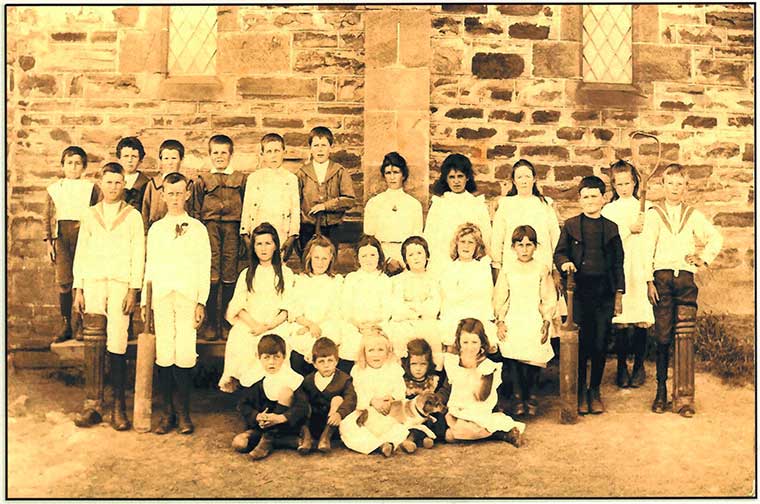
Convent shool children: Date and names unkown.
Before Christmas each year the children and a couple of adults carried out a spring-clean of the whole building and its contents, including scrubbing the Church floor. This was accompanied by a recitation of the 'times tables' and various prayers, so there was no time for complaining! In any case the work was regarded as a welcome break from school routine and the following 'break up' party was always a fitting reward for our efforts.
Attendance was erratic. As elsewhere when a new baby arrived in a household, older girls were kept at home to help, and sometimes boys were needed on the farm. The Sisters encouraged them to keep up their education, providing lessons for them to do in whatever spare time they had.
Times were hard for everyone but the Sisters accepted all pupils whether they could pay or not. Throughout the years, as well as religion and the 3R’s, they taught various useful crafts with whatever was available. Both girls and boys were taught to knit and do simple sewing, little ones made yards of ‘tomboy stitch’ to decorate pot holders and cushions, girls made doll clothes and boys made match holders to hang near the fireplace and they all hemmed pieces of flannel as pen wipers. These homely skills could become necessary in times of hardship in later life and the best of them were chosen for a stall at fundraising fetes.
Some of the Sisters were strict disciplinarians, as they needed to be with some of the older, high spirited boys. Many boys were trained as Altar boys to assist the Priest at Mass and girls too learned to answer Mass in Latin, but from the front seats, not on the Altar in those days.
Some extracts from the Sister’s letters to Mary MacKillop, and selected diary entries, give some sense and feel of those early pioneering days.
9 June: “The only thing that makes us anxious is that so few children have come to school as yet... of our seven pupils, three cannot read and the others know very little... Mr Ryan frosted the windows for us. Mrs Lewis sent some calico which we made blinds of, so that our schoolroom looks quite respectable, and all we want now is a few desks, a few books and a great lot of pupils."
11 June: "Another scholar this morning doing vulgar fractions. Nice piece of business.”
June: “We had 22 children this morning, two boys taller than myself."
28 June: ”We had a load of wood sent yesterday, so the people are very kind. Sister Kate is very well but she is frightened that the place will blow away."
5 July:
Monday: Seven new pupils.
Tuesday: Annie and I went begging. Walked four miles. Got a loaf, tea, sugar.
Wednesday: Went out again to beg. Got more than the day before.
Friday: A woman gave me some cloth for scapulars.
Saturday: A man brought a blackboard. Annie and I cleaned the church.
July: “39 on roll — more coming...Gave ...four pounds twelve shillings for the safe...”
July: “40 children — Fr Murphy in school on Friday. He went thru all the classes. Something new for these children to be questioned by a priest. We went to see a woman who was sick about three miles from here. I am getting used to walking now...”
18th July: “... went begging... 4 miles... got one loaf... but dropped a tin of soup in the creek. Was teaching Second Division — 13 boys and girls.”
1909: By 1909 the school was closed and the Convent became a home for people in need. One theory is that the number of pupils had dwindled, other areas were being developed and the Sisters were needed elsewhere, particularly during the war years. During that time the children attended the Primary School and Miss Mary McMahon taught Sunday school in Mr. J. J. O’Malley’s store room on Parin Street. But by 1919 the school was flourishing again and the people welcomed the Sisters back, the town had grown and there was better transport available.
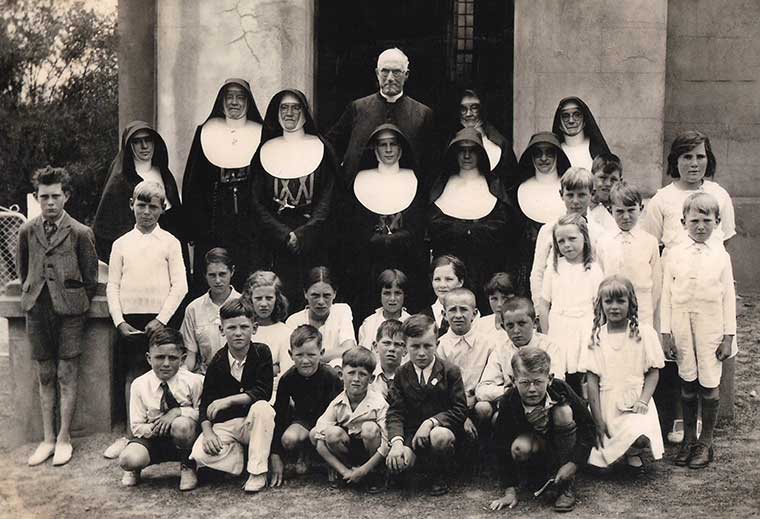
1937 Back to Macclesfield State Centenary.
Back: Rev Father FALLON. Not sure of Sisters’ names - Sr. Blandina on his right facing camera, others perhaps Sr. Leonora, Sr. Jerome). Sr. Francis de Sales one of those on his left (Sr. Wenseslaus, Sr. Agneta others perhaps).
From left: Dennis McNAMARA, David SMITH.
1st Row Girls: Betty LEMAR, Shirley STEVENS, Patricia McNAMARA, Winifred LEMAR, Delia BRENNAN, Betty McNAMARA, Patsy DWYER, standing.
Boys: Bernard VANINETTI, Michael BRENNAN, Leo BRENNAN, Frank McCUE, Rodney McNAMARA, ?, Olympio FARCA, Bruno VANINETTI, Paul WHITTLE.
Group Standing: Stanley SMITH, ?, Bill McNAMARA.
At Back: Mary COSGRAVE, Girl in Front: Unknown.
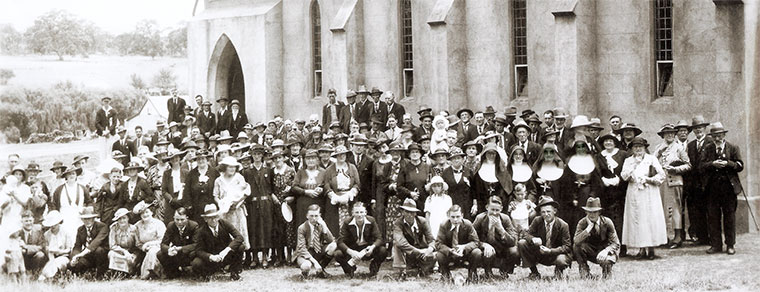
1937 Jan: Back to Macclesfield State Centenary.
In the crowd in the image above:
Girlie McNAMARA, May FOLEY, Guerin McNAMARA, Lance MURPHY, Miffy McCUE, Ted BURNS, Mrs L McNAMARA, Tom COSGRAVE, Mrs M BRENNAN, Mrs O'MALLEY, Philip COSGRAVE, Tom COSGRAVE Jnr, Mrs WATERS, Mrs Catherine McNAMARA, Mrs Catharine COSGRAVE, Stan KEANE, Pat NESTOR, Tom McNAMARA, Martin PURCELL, Denis COSGRAVE, Mrs Kath HALLS (SMITH), Mrs JORDAN, Mrs M O'LOUGHLIN,
Miss Mary McNAMARA, George HAY, Tommy BRENNAN, Paddy MAGIN, Pat and Mike KAVANAGH, Mr KAVANAGH Snr.
New School building
From time to time it was evident that a proper schoolroom should be built but for various reasons it was postponed. When World War II ended the Army Convalescent Camp at Strathalbyn was decommissioned and in 1947 when the buildings were sold the Parish purchased one for a schoolroom.
Volunteers were again to the fore to clear an area near the footbridge, level the ground and prepare the foundation and the building was transported ‘holus bolus’ and set in place. It was originally partitioned into two rooms; one doorway faced the footpath, the other faced the creek and there are still two circles in the ceiling where the chimneys of two small wood stoves were vented. It was Blessed and opened by Archbishop Mathew Beovich on September 7th 1947. A second building was added in 1960, Blessed and opened on March 12th. The builder was Murray Gilbert of Meadows with much volunteer help.
As time went on an assembly area was prepared incorporating a tennis and netball court. The boys played cricket or football in the larger area beside the Church.
1971: The Convent School closes.
Time moves on and by 1971 the number of pupils had dwindled; the school was closed and the remaining pupils transferred to the Primary School. The Sisters then established a Motor Mission; this involved a great deal of travelling which eventually took its toll, and, with the trend towards weekend camps and seminars, the role of the Sisters changed to that of Parish Workers and Coordinators and their influence can now be perceived over much wider spheres of work.
Sister Mary Canny and Sister Pauline Schutze came to live in the Convent and instruct the children in the surrounding area. They attended State Schools where Ministers of Religion were permitted to visit for half an hour to instruct children of their denomination. They covered an area of 13 schools as well as Sunday classes, and weekend camps were organised for High School students. In 1973 Sister Elizabeth Brown replaced Sister Mary Canny at Macclesfield and the work continued with hours of driving in all weather. Sister Pauline was eventually appointed to Birdwood as Parish Worker and Sister Kathleen came to our Convent as companion.
1996: For a few years instructions were held in the school building during the holidays with some of the local parents as facilitators, but eventually the Sisters were again needed elsewhere.
The Convent became a Rest and Retreat House until 1996 when Sister Kateri Duke, one of 1300 Sisters of St Joseph who work among people in Australia, New Zealand, Ireland and Peru and in short term ministries in Cambodia, Africa, Brazil and other developing countries, took up residence and commenced her practice in natural healing while continuing the usual caring work of Mary MacKillop.
She initiated the Good Friday Way of the Cross on the Square for all denominations, and helped to launch the Spirituality in the Pub program. With others she set up a natural healing clinic as well as helping with other Parish activities. Eventually her talents were needed elsewhere and Sister Mary Reardon arrived to live among us and take part in town and Parish life.
2007 - 150 years of Education, 2-3rd November
“The Catholic community of Macclesfield joined the local State School in celebrating its Sesquicentenary. For 99 of those years the Sisters of St. Joseph conducted the Convent school as it was known, and also taught music.
During the afternoon Sr. Mary presented a set of library books to the Primary School on behalf of the Sisters of St. Joseph. During her address she congratulated the school on the “interaction of the two schools throughout the years when typically, there were times of intense rivalry and times of productive co-operation! It is really important that we pause occasionally and reflect on the significance of our school in the life and history of our lovely town. We cannot overestimate the role that a school plays in its very important role of affirming and supporting parents in their task as primary educators of their children. We thank you and all those who have gone before you in the century and a half of formal education here at Macclesfield.” The next day the head teacher Mr. Milne gave her a special tour of the school and its display.
Music education was a continuing feature of the educational endeavours of the Sisters and a way in which they contributed to the cultural life of many rural communities.
Annual school concerts were a feature of late 19th and 20th century school programs and provided an opportunity for showcasing the performance of private music pupils.
Since the closure of the school in 1971, the Sisters have had a continuing presence in the educative processes of the district by their work in religious instruction of children and their participation in liturgical ceremonies.
2010: In May 2010 the Parish celebrated the contribution of the Sisters to the local area since the original foundation with the unveiling of a commemorative plaque fixed to a rock opposite the old school buildings, and the naming of the ‘Mary MacKillop Way’ through the Church grounds.
During her address Sister Mary Reardon noted that although the school had been sold, “we were facing a building where teaching and learning had happened in the past and where the Playgroup now meets to equip our children to face a future as yet unimagined, and the Newsletter continues to inform and entertain us and record the events that help to shape the present and invite our creative contributions to the future.
We walked down the hill where residents had walked since earliest white settlement and beyond and the ceremonial cutting of the ribbon” by the youngest member of the local congregation, Bede Cobiac, “was a moment of rich symbolism, a linking of past, present and future in living continuity”.
Sister Mary Reardon R.S.J.
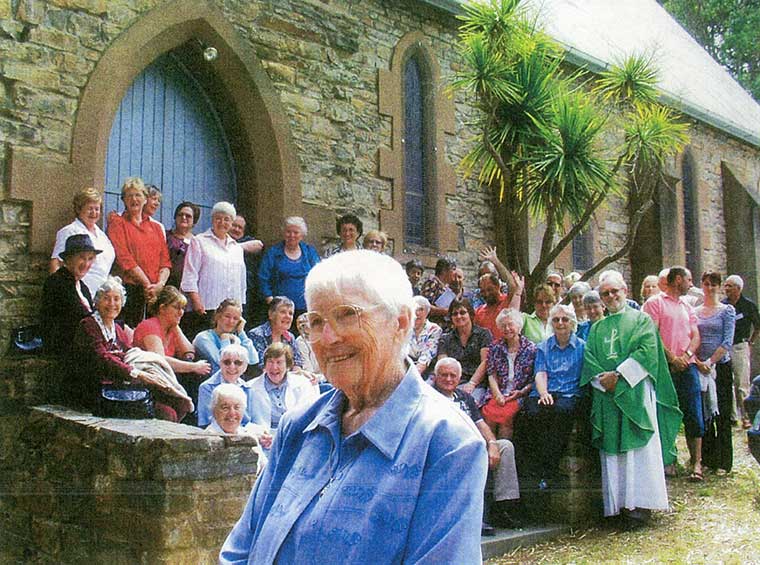
Farewell to the last Josephite to reside in Macclesfield, 2011.
From “Celebrating Beginnings”, compiled by parishioner Gerald O’CALLAGHAN.
Canonisation of Sister Mary MacKillop
During the weekend of October 20th 2010, Sister Mary Reardon was the driving force when the Parish celebrated the canonisation of Mary MacKillop, our first Australian Saint. The event was held at Auchendorrach House, Mount Barker, a fitting venue as it was once the home of Joanna Barr Smith, a lifelong friend of Mary MacKillop. Sister Mary worked tirelessly to gather her helpers, prepare the program, allot jobs to those involved, help to gather items for display and attend to all the details needed for such an event.
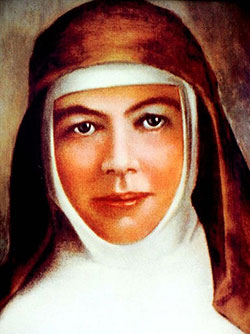
Mary Mackillop
The weekend was an outstanding success and with her usual wisdom she arranged a function to thank her helpers. However, her health began to fail and eventually, as a unit became available at Kensington she decided to move closer to facilities, leaving many friends who were honored to have been a part of her life.
Sister Mary Reardon was the last Sister to live in our Convent and on leaving had remarked that the Sisters had always felt that they were living among friends when at Macclesfield.
The Convent has now been sold and as Fr. W Modystack wrote in his Parish notes, “It would be impossible to put into words all that the Sisters have done in this Parish in the spirit of their Foundress Mother Mary of the Cross to bring the message of Christ into our lives”.
2017: Now, plans for the Mary MacKillop atrium to be conducted in St. James the Less Church are well under way. The atrium is part of the catechesis of the Good Shepherd, a spiritual formation process begun by Maria Montessori and Sophia Cavaletti for 3 – 6 year olds. Thus, history is revisited and education again will be taught in the Church.
Value of the Sisters to Macclesfield
During their years amongst us the Sisters gained the love and respect of people from all walks of life. They were a familiar sight as they went on various errands of mercy; one non-Catholic lady was heard to say, "When my husband died, the Sisters were the first ones to come to me", a sentiment also expressed by many others on numerous occasions.
They even helped put out bushfires: from “The Southern Cross”, Friday, January 13, 1939, “Nun's Good Work in State's Worst Bushfire - Outbreak at Convent as Sisters Help Fire-fighters”
“The heroic work of the fire-fighters engaged in preventing the spread of the State’s worst bushfire, which broke out during this week's record hot spell in the Macclesfield district, was materially assisted by three Sisters of St. Joseph at the Convent, Macclesfield.
At one time the whole town of Macclesfield was threatened with destruction. The Nuns, working in a shade temperature of about 117 degrees, which at Macclesfield must have risen to a much higher figure on account of the burning countryside, carried gallons of water to the convent which with their own supplies they made tea for the fire-fighters. While the men were being supplied with food and drink at the convent, the fire contacted with the convent property, and the Sisters with their guests succeeded in putting it out, but not before a woodshed had been completely destroyed. Much appreciation was expressed for the good work of the Nuns.”
As well as teaching at the school they also taught music and the yearly concert by the school children always played to a 'packed house'. For many years the Convent and Primary School's combined picnic was an eagerly anticipated event, with fancy dress, decorated bikes, prams and billy carts, a pet show and races and lolly scrambles on the Square.
In later years the Convent joined in the Alexandra Shield Combined Schools' Picnic Sports and these sports days were always a great occasion.
Annual Concerts
Extract from "Glimpses From the past" - Macclesfield, August 1936
“A capacity audience attended the annual concert given by the pupils of St. Josephs' Convent in the Institute. With only 25 students, the programme submitted was most enjoyable and the costumes artistic and attractive, continuing the high standard notable for these events. Mrs. C. O'Brien and Miss Joan Dugmore were accompanists.
The concert commenced with the children singing 'The Song of Australia' and 'The Boree Log'. Mrs. O'Brien played a pianoforte solo, after which a humourous item 'A Long Pull and a Strong Pull' with Mary Cosgrave as the 'nurse', Barbara Bradbrook as 'Mrs. Brown', Mervyn Stevens 'Master Brown' and Laurie Brennan as 'Doctor Linseed' was presented.
Next was a solo 'Ireland I Love You' sung by Laurie Brennan. An encore was demanded from little Bernard Vaninetti for his recitation 'Little Fella with his Mammy's Eyes'. A solo 'A Voice from the Green Isle' was sweetly sung by Patty McNamara, and then the juniors recited the days of the week with Jacqueline Bullock as 'Monday', Francis McCue 'Tuesday', Rodney McNamara 'Wednesday', Leo Daly 'Thursday', Peter McNamara 'Friday', Bernard Vaninetti ‘Saturday' and Francis Brennan ‘Sunday'.
The senior boys' action song ‘Heads and Heels' by Laurie Daly, Phillip Cosgrave, Robert Smith, Geoffrey Barnett and Laurie Brennan caused much merriment and a solo 'Little Boy Blue' was then sung by Francis Brennan. The girls‘ 'Grandmothers' Song' with Shirley Stevens, Mary Cosgrave, Beryl Bartlett, Patty McNamara, Kathleen Daly, Barbara Bradbrook, Betty Bullock and Betty McNamara, all dressed as old women, was a very popular item.
The concluding item enchanted the audience as four tiny couples, dressed in their flower and honey bee costumes from the previous item, danced the Alberts. The couples were Jacqueline Bullock and Leo Daly, Patsy Dwyer and Francis McCue, Shirley and Rex Stevens, Betty McNamara and Francis Brennan.
At the conclusion of the concert the Rev. Father Fallon P.P. congratulated the Sisters on the excellent training of the children and all concerned with costumes, lighting, etc. to enable their vision to become a reality and especially thanked the audience for attending.
The Hall was cleared for dancing with Mr. H. Pfeiffer's band supplying the music. Mr. Cecil Yates was M.C. and Messrs. Clem O'Brien and Pat Nestor had charge of the door. A delicious supper supplied by the church ladies concluded an enjoyable and successful evening.”
1883 First Catholic Sports Picnic
The Hibernians (Catholic Lodge) held their annual picnic on St Patrick’s Day but in 1882 decided to change to New Year’s Day and commenced raising funds to pay for the recently completed bridge from Venables Street to the Church Grounds as well as other facilities that were needed. A new committee was formed with John O’Malley (President), Mike Kavanagh (Secretary) and ‘Big’ Tom O’Loughlin, Bart Hoobin, Patrick Kavanagh, Martin Considine and Jack Salmon as members.
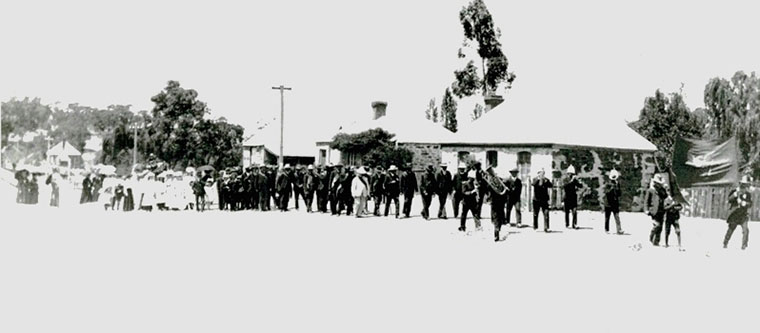
1909 Procession to Catholic Picnic from St James -
Hodder’s Band leads the Procession along Venables Street on New Year’s Day
With the help of many locals a program of foot races, jumping and other competitions was arranged and the event was a great success.
The Catholic Picnic has been held annually ever since. It evolved over the years with various attractions of the times including Irish Dancing, Bicycle Racing, Guess the Weight of a sheep – the prize being the sheep, Sheaf Tossing, Log Chopping and a Dog Show. Horses in Action was included and continues today. For many years the Grand Ball at night was always voted as the best for the year with dancers from far and wide attending and ‘dancing kept up until the small hours’.
From the beginning fundraising was to the fore and there are numerous reports in the newspapers of picnics, assemblies, concerts, lectures and dances. From 1940-1946 half of all monies raised went to the Red Cross and the Fighting Forces Comforts Fund. Martin & Madge Purcell were among the many volunteers who raised money for the picnic fund. In the period between 1955–1981 they raised the equivalent of $125,000 in today’s money.
The Catholic Picnic was postponed at different times for fire or flood but was always held as soon as conditions improved. However, it was cancelled four times. In 1915 when the picnic was in full swing a massive storm broke, causing the event to be cancelled, visitors stranded overnight and roads and bridges washed away. In 2005, it was abandoned through lack of volunteers, in 2008 the show was cancelled due to Equine Flue and in 2015 it was cancelled due to the Sampson Flat Bush Fire.
The Centenary Picnic in 1983 was celebrated with a ‘Grand Days Entertainment’ and as the ‘Grand Ball’ had been discontinued a few years before, it was commemorated by a well-attended Bush Dance at night. In the ensuing couple of years the ranks were thinning, age and health was taking its toll on the Committee, and it was decided to discontinue the event. However, a group of enthusiasts quickly formed a new Committee and from that time on it was known as The Macclesfield Horse Show. This is still held annually, with the proceeds benefitting many local clubs.
A tribute in 1935 recorded that ‘it says much for the fine spirit of the old pioneers of the district that their children stand by one another ‘irrespective of creed’ and the same can be said of the Macclesfield Horse Show today. The 132nd Show will be held on the 7th January 2018.
End Note
These pages are not intended as a comprehensive history, but are a record of some of Parish life during the last 150 years and to honour the generosity, love and sacrifices of the people who ‘built’ their parish both physically and spiritually. Whether church goers or not they were part of our life as a church community and enriched us with their presence.
References
These notes contain extracts from various newspaper reports, oral memories, ‘Strathalbyn Parish Historical Notes’ booklet by Fr. W. Modystack P.P., booklets ‘Celebrating Beginnings’, ‘An Australian for Australians’, ‘Hear my Voice’ and other written articles by Gerald O’Callaghan, and Macclesfield Newsletters “Glimpses of the Past”, articles all used with permission.
Acknowledgements
Betty White (nee McNamara) - decades of Macclesfield research and words.
Betty is a longtime parishioner of St James the Less. She is also a member of the Macclesfield History Group and was helped by fellow members Lesley Schack and Daryl Stevenson to create this booklet.
You can contact the history group via our website: www.macclesfieldhistory.com.au
This booklet can also be found on the above website. A Search Button on the front page can be used to find any name or event within the website and booklet.
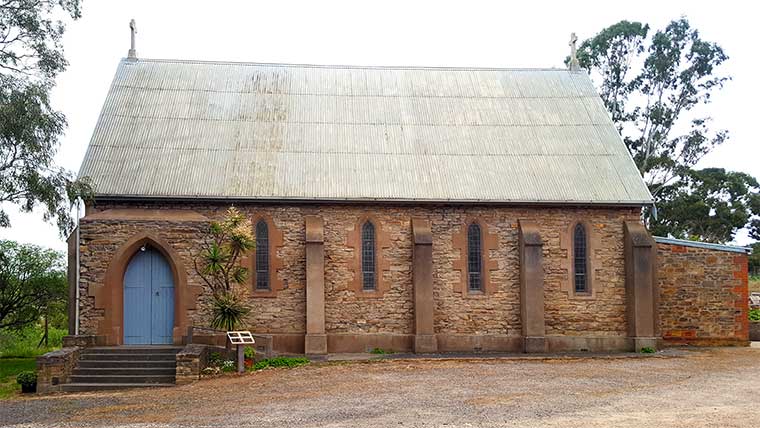
St James the Less Roman Catholic Church October 2017
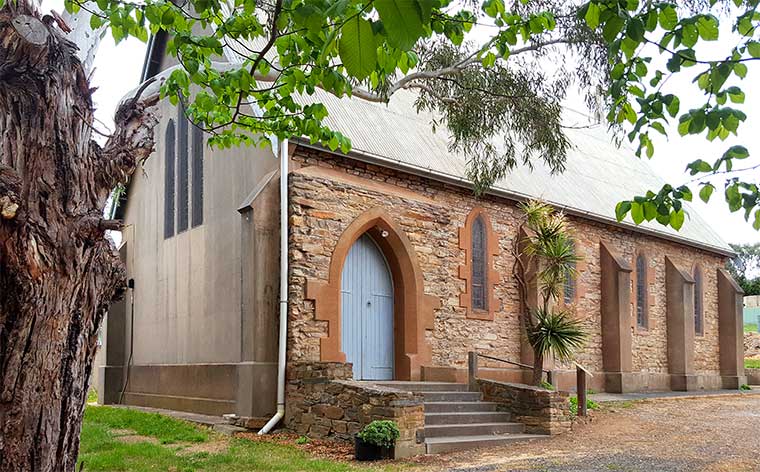
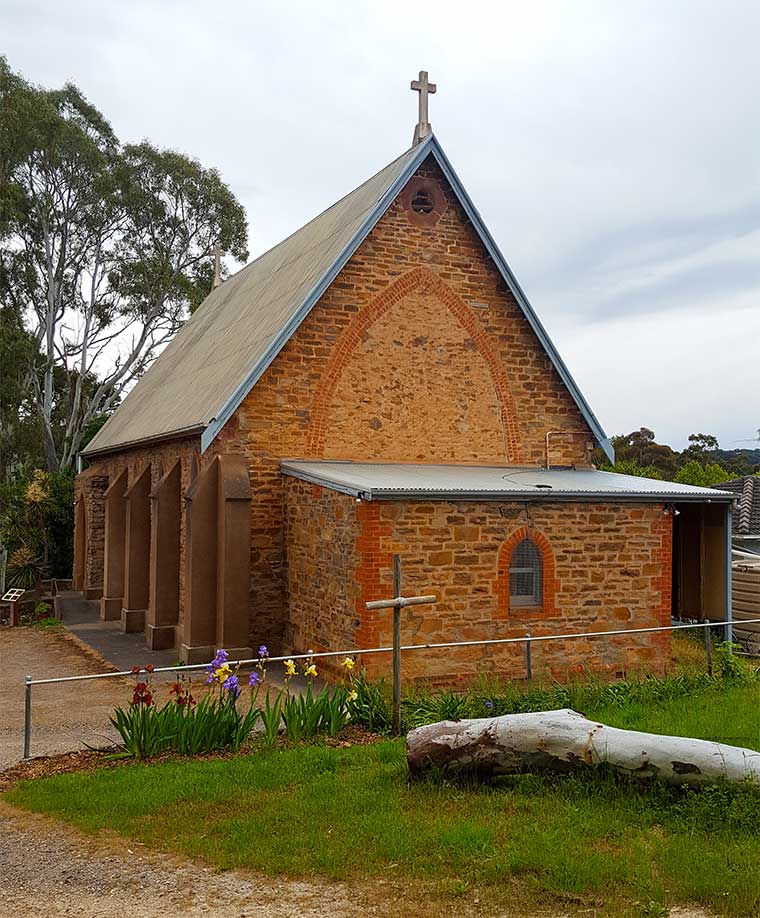
Timeline
1832, 15 Nov. Julian Tenison-Woods born in London
1842, 15 Jan. Mary MacKillop born in Fitzroy, Melbourne.
1848 Parish of Mt Barker established, large and included Macclesfield.
1854 Meeting at Davenport Arms to consider building Church.
1856 Rough “slab tenement” chapel built, worshipping in 1858, possibly lived in later by Convent sisters.
1866, Oct 29. Visit by Dr Shiel, decision to build church (and in Strath).
1866 Mary MacKillop and Julian Tenison-Woods co-found the Order of Sisters of St Joseph of the Sacred Heart, at Penola.
1867, 3 Nov. Church foundation stone laid.
1867, 14 Nov. First wedding in Church.
1867, Sept. Tenison-Woods visited, as SA Director of Catholic Education.
1868, June. Convent opened by Sisters of St. Joseph.
1869 Sisters teaching in school building by now.
1871 Convent closed.
1875-1909 Convent operational.
1881 New Convent possibly started. Foundation Stone laid Oct 17, 1880.
1882 Footbridge built.
1883 Macclesfield Catholic Sports Picnic started, annual event. Initially to pay off debt remaining on the church + the footbridge.
1883 Public Cemetery established. Catholic given area but not fenced off.
1889, 17 Oct. Julian Tenison-Woods died.
1906, 16 Feb. New parish of Macclesfield + Strathalbyn formed.
1909, 8 Aug. Mary MacKillop died.
1909 Convent closed.
1917 Church renovated.
1920-1971 Convent operational.
1927 27, Sept. Major repairs done, church re-dedicated, “Back to Macclesfield” Diamond Jubilee.
1936, 7 Jun. Gala Day to celebrate footbridge re-opening after renovation.
1940-1946 Picnic Fund raised monies for Red Cross + Fighting Forces Fund.
1945, 15 Aug. End of World War II
1955-1981 Picnic Fund raised $125000 in today’s money.
1971 Convent closed.
1977 110th Anniversary - more repairs.
1983 3 Jan. Centenary Picnic
c1986 Catholic Sports Picnic became the Macclesfield Horse Show
1987 Footbridge “structurally inadequate”, became a public right of way after renovation by Strongcrete Constructions of Macclesfield.
1992 125th Anniversary of church.
2017 5 Nov, 150th Anniversary of St James the Less Catholic Church.
2018, 7 Jan. 132nd Macclesfield Horse Show (originally Catholic Picnic)



